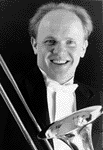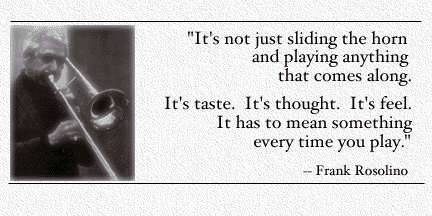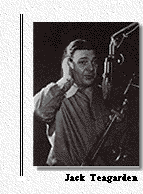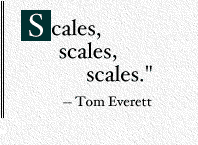It Has to Mean Something Everytime You Play: Advice from Some Trombone Masters
 The proverbial New York City tourist who asked how to get to Carnegie Hall was told to "practice, practice, practice," but most of us want more detailed directions. How much should one practice? Is perseverance more important than luck? Or is it simply a matter of knowing the right people?
The proverbial New York City tourist who asked how to get to Carnegie Hall was told to "practice, practice, practice," but most of us want more detailed directions. How much should one practice? Is perseverance more important than luck? Or is it simply a matter of knowing the right people?
The secrets of success are both surprising and predictable, as revealed by a dozen or so of the top twentieth-century trombone soloists. Their advice is a wonderful blend of what to do and what not to do. Beyond scales, lip slurs, and mouthpieces, they also have much to say about the mental and spiritual aspects of musical performance.
To those trombonists who aspire to a career, J.J. Johnson cannot say the word "practice" enough. "I've tried to drive the point home to young players that they have got to practice," he once told an interviewer. "There won't come a time when you won't have to practice anymore (Baker, p. 18). Johnson nevertheless recommends some moderation. He feels that the "no pain, no gain" method is unwise. "Don't practice to the point where you're beating it to death and your lips are aching," he warns (Everett, p. 29).
Johnson's thoughts are echoed by Arthur Pryor, Ralph Sauer, Christian Lindberg, Albert Mangelsdorf, and others. When Pryor's administrative duties kept him from the two hours daily practice which he considered minimal, he would ask his conducting assistant, euphoniumist Simone Mantia, to fill in for him as soloist. Sauer has trouble finding much more than an hour a day to practice, but he religiously finds that time. He advocates practicing in short segments of ten to twenty minutes. "That way your mind doesn't lose its focus," he says, "and [it's] more realistic as far as the demands on a professional trombone player are concerned" (Driscoll, p. 22). Lindberg recalls that when he first studied trombone (with Sven-Erik Eriksson of the Royal Stockholm Opera Orchestra), he practiced three twenty-minute periods a day. Mangelsdorf also says that practice is the sine qua non. "I practice to be able to do the things that come to my mind when I play," he says. "But that doesn't mean I practice these things--I never do. I just practice the trombone as an instrument" (Tomkins, p. 32). He feels that it is especially important to keep practicing while on tour in order to maintain both technique and assurance.
What specifically should one practice? Oddly enough, adaptations of exercises for other instruments have been popular professional tools. Lindberg recalls practicing both the Arban and the Schlossberg trumpet etudes. Pryor had students learn arias and hymns. Although encouraged to do so, Pryor never wrote a method book. He felt that such a book would be superfluous, saying "let them learn the hard way, like I did" (Frizane, p. 44). However, Stuart Dempster wrote the book which has become the Bible of contemporary trombone techniques. In The Modern Trombone he systematically takes up such complex subjects as multi-phonics, percussion devices, phonetics, and body sounds. Dempster also recommends studying the Hindemith Sonata because it calls for performance skills which are useful in many kinds of music.
Vinko Globokar, another avant-garde musician, has a strong commitment to exploring new means of expression, but he respects the time-honored exercises. "It is unthinkable to be an interpreter of contemporary music," he says, "without having a deep, traditional knowledge of the instrument" (Globokar, p. 25). Johnson, on the other hand, has another one-word answer to the question of what to practice: scales. In an interview with Tom Everett, he expanded that answer to: "scales, scales, scales" (Everett, p. 27).
Twentieth-century trombone soloists see the development of instrumental technique as crucial but certainly not an end in itself. Carl Fontana warns against playing too fast. "Ninety-nine and nine-tenths percent of trombone players play too many notes," he says. "I would recommend to all trombone students to have reasonable technique. It's the misuse of technique that I'm against" (Rusch, p. 20). Fontana cites trumpeter Bobby Hackett as an example of someone who plays only a few notes but plays them beautifully.
At his frequent workshops and clinics, Frank Rosolino told students to "be aware that technique is one thing, and how you use it is another....Just as you have to learn how to walk before you can run, so you have to start out learning melodies, developing an ear, and then building from there" (Underwood, p. 44).
Despite his complete technical mastery, Jack Teagarden was a restrained player who rarely called attention to his virtuosity. In recordings such as The Sheik of Araby (1944), My Bucket's Got a Hole in It (1950), and Body and Soul (1953), one hears his intensely personal and deceptively simple style.
 |
Agile tonguing is a vital part of trombone technique, and there is a surprising amount of unanimity on how to increase speed. Fontana and Rosolino are among the many who suggest modifying the standard "tu-ka-tu-ka" pattern to "doodle-doodle." So did Kai Winding and J.J. Johnson. However, double-tonguing is not a panacea. Much of Johnson's playing on such classics as Coppin' the Bop, Hey Pete, and The Champ is single-tongued, for greater clarity and precision.
Tone quality is another preoccupation. According to Pryor's students, a pleasing tone and singing style were his primary pedagogical goals. Bill Watrous, whose lively performance style and personality make him a popular clinician, often talks about the need to know the lyrics of a song in order to interpret it with the right sound. Dempster has a favorite exercise for getting students to become aware of tone quality: "Play in dead practice rooms, the worst ones you can find,...and make them sound resonant" (Samson, p. 33).
Trombonists, like tuba players, tend to be freer with helpful hints than trumpet or horn players. Teagarden started fellow trombonists using Pond's Cold Cream on their slides, and later he urged them to switch to the cooking lubricant Pam.
 Rosolino and Winding were on the payroll of, respectively, the Conn and the King instrument companies, but both were careful to tell students that the solution to performing well is neither in the instrument nor the mouthpiece but in the person. "YOU," Winding would often state emphatically, "must play the instrument; it does not play itself" (Tomkins, p. 23). Winding's clinics never failed to enlighten, inform, and inspire. After the 1977 International Trombone Workshop in Nashville, Joe Owens wrote: "I gained more in my personal knowledge of how to approach jazz...from this ninety-minute session with Kai than I've learned in over thirty years of teaching and performing" (Owens, p.8).
Rosolino and Winding were on the payroll of, respectively, the Conn and the King instrument companies, but both were careful to tell students that the solution to performing well is neither in the instrument nor the mouthpiece but in the person. "YOU," Winding would often state emphatically, "must play the instrument; it does not play itself" (Tomkins, p. 23). Winding's clinics never failed to enlighten, inform, and inspire. After the 1977 International Trombone Workshop in Nashville, Joe Owens wrote: "I gained more in my personal knowledge of how to approach jazz...from this ninety-minute session with Kai than I've learned in over thirty years of teaching and performing" (Owens, p.8).
Other helpful hints are generously offered by Urbie Green, who, strongly recommends taking lessons, learning theory, studying music history, and so forth. Although he frankly admits having done little or none of this himself, he feels that his life would have been easier and his progress smoother had he done so. Both Green and Fontana suggest the study of recordings. As a young player Green listened avidly to other performers, played along with recordings and the radio, and thereby developed a technique to match what he heard. Fontana advises against listening only to trombone players. In addition to Hackett, he says "listen to Parker, Stitt, Coltrane, [and] Getz" (Sloan, p. 11).
Another of Fontana's themes at clinics is the difficulty of a professional performer's career. He strongly recommends getting an alternate degree, or at least a music teacher's credential. "Music is no fun if you have to scuffle for a living," he says. (Rusch, p. 16). Luckily, though, he did not follow this course in the early 1950s but instead continued to play his instrument so remarkably well that he helped establish the trombone as a jazz instrument which could hold its own with the trumpet and the saxophone.
 |
"Shallow men believe in luck," said Ralph Waldo Emerson. Perhaps these master trombonists agree, because none of them discuss the subject, at least directly. Their message invariably boils down to something like: "keep working hard while you wait for that lucky break." An overnight success is generally ten or a dozen years in the making. If a part of luck, however, is knowing the right people, it can be said that many of these great performers are lucky. They all seem to have learned the importance of good networking and that it is part of making one's own luck.
The seasoned professional, however, neither counts on luck nor focuses excessively on technique. With too much attention on scales, tonguing exercises, the improvement of tone quality, the choice of equipment, and so on, one can easily loose perspective. Here again the top twentieth-century soloists have something to say and they often say it eloquently. "A musician," reflects Lindberg, "has to be able to function like an actor who knows his part before he goes on stage. That's the only way of getting the musical message across" (Ketting, p. 17).
Urbie Green also has wise words for aspiring performers. Shortly after he won the Down Beat award in 1954, he said: "When the opportunity presented itself, I did the best I could no matter what the job was--even though the music at times was hard to take. It sounds corny, but if you give people a little more than their money's worth, you can generally move ahead" (Hentoff, p. 2). However, the mercurial Frank Rosolino, who frequently homilized about the means and ends of performing, put it best: "It's got to come from the soul," he used to say. "It's not just sliding the horn and playing anything that comes along. It's taste. It's thought. It's feeling. It has to mean something every time you play" (Underwood, p. 44).
Trombonists who aspire to a professional career have a tough row to hoe, but no other life seems to have been possible for these master performers. All attribute their success to doing something they really believe in. While they may not be able to tell us exactly how to get to Carnegie Hall, they can at least point us in the right direction and encourage us along the way.
